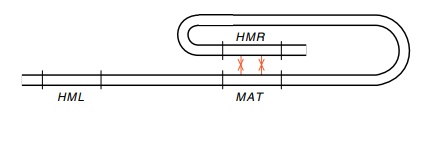Chapter: Genetics and Molecular Biology: Regulation of Mating Type in Yeast
Expression and Recombination Paradoxes
The Expression and Recombination Paradoxes
Two important questions are raised by the structure
of the mating-type loci and the locations of transcripts in MATa and MATα. First, how is transposition
always forced to proceed from HML or HMR to MAT and never the reverse, and second, how is expression of a or α from HML or HMR prevented?
Relatively little is known about the biochemistry
of the transposition reaction. The available data suggest that a direct
transfer of DNA through a free diffusible intermediate does not occur, but
instead that mating-type shift is a result of gene conversion type of substitution reaction in which the
appropriate information from HML or HMR is copied into MAT (Fig. 16.6). In part, this conclusion is based on the failure
to find free DNA copies of sequences from HML
or HMR in yeast.

Figure 16.6 Folding the chromosome to bringHMRnearMATso copiedsequence information can be passed directly from HMR to MAT.
One simple method for expressing sequences at MAT and not express-ing the sequences at
HML or HMR would have been for the region around MAT to provide a promoter that specifies transcription across
whatever sequence has been inserted at MAT.
This is not the explana-tion, however, for transcription of α and a
genes begins from within the mating type-specific Y sequences. Another possibility is that an en-hancer is near the MAT region so that whatever is inserted
into MAT is expressed. It is also
possible that repression occurs at HML
and HMR.

Figure
16.7 Something has to act at a
distance to regulate the promoters ofmating type genes. Either repression acts
from afar at HML and HMR or activation acts over a distance
at MAT.
Since it is hundreds of nucleotides from the mating
type-specific pro-moter to sequences unique to the HML, HMR or MAT loci, activation or repression would
have to occur over a substantial distance (Fig. 16.7). While such “action at a
distance” events are frequently found for activation of transcription, they are
less often seen for repression of transcription. Nonetheless, genetics experiments
revealed that it is repression at HML
and HMR that actually occurs. This
same repression or silencing mechanism of the mating-type promoters also blocks
trans-fer of the donor information at HML
and HMR to MAT.
Related Topics